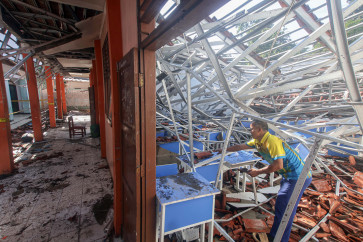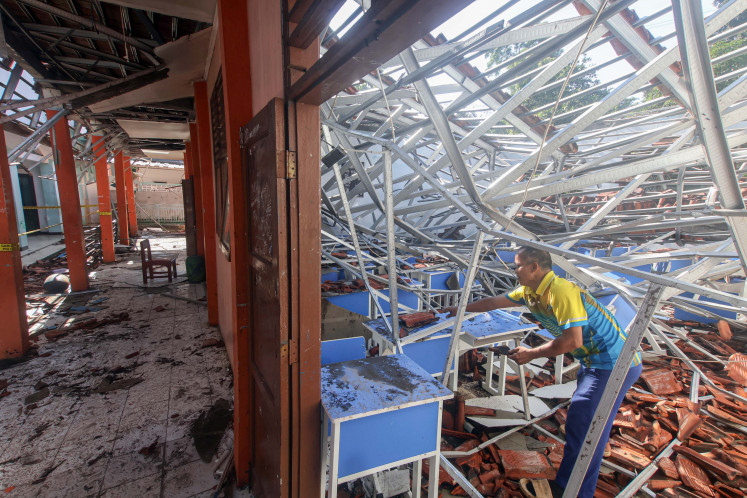Popular Reads
Top Results
Can't find what you're looking for?
View all search resultsPopular Reads
Top Results
Can't find what you're looking for?
View all search resultsEasing traffic through a smarter system
Among our region’s great cities, Jakarta has been cited as the city with the world’s worst traffic
Change text size
Gift Premium Articles
to Anyone
A
mong our region’s great cities, Jakarta has been cited as the city with the world’s worst traffic. With no rapid transit system, and a public bus system that carries just 400,000 people a day, the capital’s streets are hit every workday by 9.9 million cars, motorcycles, trucks and other vehicles, according to the Jakarta Transportation Agency, with nearly 2 million of them driving in from neighboring municipalities in the provinces of West Java and Banten.
The statistics are jaw-dropping — it can take two to three hours to drive 40.23 kilometers to the center from Bogor, the largest of the satellite cities; 70 percent of the city’s air pollution comes from vehicles; and the average Jakartan spends 10 years of their life in traffic. And it’s getting worse — the city’s 9.5 percent average annual growth rate of motorized vehicles far exceeds the 0.01 percent increase in road length achieved between 2005 and 2010.
However, after 40 years of discussion and 25 studies, construction is finally under way on Jakarta’s US$1.7 billion metro line. The rail-based Jakarta MRT is expected to cover over 108 kilometers, including 21.7 km for the North-South Line and 87 km for the East-West Line.
The first phase of the North-South Line, a 15.7 km stretch with elevated and underground stations, is scheduled for completion in 2019 and will serve 212,000 passengers per day, reaching up to 960,000 per day.
Jakarta’s authorities also see a Bus Rapid Transit system as contributing to commuters’ relief. In 2004, Jakarta became the first Southeast Asian city to open a BRT. The Transjakarta system uses diesel and CNG-powered buses over a 193-km network that includes a 12.9 km separated median busway corridor through the city center.
The operators of the BRT and MRT have said seamless integration of the services will benefit both parties.
The Jakarta authorities have finally taken steps to follow Singapore’s lead in developing mass transit projects. However, one remaining challenge is managing private automobile traffic and how to integrate it into a comprehensive urban transit system.
The poster boy for urban traffic management is definitely Singapore, which in 1998 pioneered the world’s first Electronic Road Pricing (ERP) system. This congestion pricing system deducts the toll via a pre-paid in-vehicle unit, electronically triggered when the vehicle passes under a purpose-built gantry.
Singapore is now field-testing another world first — an ERP system based on satellite navigation technology instead of physical gantries. The system will have island-wide coverage, and will charge for actual distance travelled. It can also facilitate coupon-less street parking and will provide all road users with real-time traffic information through an intelligent onboard unit.
The benefits to road users and authorities from such an advanced system are enormous, and the key to making it possible is our growing ability to gather and analyze massive quantities of data.
Transportation and traffic management make a perfect subject for Big Data analysis. The real promise of this burgeoning technology in the transportation sector is its potential to enable a truly comprehensive city-wide transit system, embracing and coordinating public and private, road and rail.
Elements of such applications are underway. Apart from improving the flow and regulation of private automobile traffic, authorities are using data analysis to manage and improve bus and rail public transit systems. Applications include accurate ridership forecasts, to route planning and frequency, to cost-saving maintenance schedules.
Intimate understanding of customer behavior and journey plans furnished by big data allows planning of additional services on the routes, such as conveniently located retail stores. It also lets the transit authority tailor communications with riders to notify them of service changes, upcoming events or weather issues that may impact service, or even targeted advertising.
Improved commuter’s experience delivered by the insightful use of Big Data will help increase train ridership, while providing new revenue sources.
A significant element of the costs of any mass transit system is maintenance. By leveraging Big Data, authorities can predict optimal maintenance requirements of the equipment — whether trains and tracks or bus assets.
Data from the sensors installed on the equipment can be analyzed faster and at a more granular level. This helps predict faults at the individual component level such as brakes, a stretch of rails etc. Authorities can then schedule maintenance of the equipment at the right time, optimizing cost and minimizing disruption.
One public rail transport provider in the United States has successfully deployed Big Data to schedule its equipment maintenance with astonishing results — mean time to failure of the equipment has been reduced by almost 80 percent to 90 percent and equipment life increased by 200 percent. This has further improved customer safety and satisfaction, enhanced equipment utilization and reduced operating costs.
If judiciously deployed, Big Data analysis can transform the transport systems of Southeast Asia’s megacities — delivering a positive impact on the environment, the economy and the quality of citizens’ lives.
Imagine a time when our cities can boast efficient, cost-effective mass transit buses and trains combined with well-managed highways and streets for private traffic! Given a combination of political will, financial resources and Big Data analysis, this scenario could be nearer than we think.
______________________________
The writer is vice president and general manager of Asia Pacific APAC-Hortonworks










